The $60 CPU Question: AMD Athlon 200GE or Intel Pentium Gold G5400? A Review
by Ian Cutress on January 14, 2019 8:00 AM ESTCPU Performance: System Tests
Our System Test section focuses significantly on real-world testing, user experience, with a slight nod to throughput. In this section we cover application loading time, image processing, simple scientific physics, emulation, neural simulation, optimized compute, and 3D model development, with a combination of readily available and custom software. For some of these tests, the bigger suites such as PCMark do cover them (we publish those values in our office section), although multiple perspectives is always beneficial. In all our tests we will explain in-depth what is being tested, and how we are testing.
All of our benchmark results can also be found in our benchmark engine, Bench.
Application Load: GIMP 2.10.4
One of the most important aspects about user experience and workflow is how fast does a system respond. A good test of this is to see how long it takes for an application to load. Most applications these days, when on an SSD, load fairly instantly, however some office tools require asset pre-loading before being available. Most operating systems employ caching as well, so when certain software is loaded repeatedly (web browser, office tools), then can be initialized much quicker.
In our last suite, we tested how long it took to load a large PDF in Adobe Acrobat. Unfortunately this test was a nightmare to program for, and didn’t transfer over to Win10 RS3 easily. In the meantime we discovered an application that can automate this test, and we put it up against GIMP, a popular free open-source online photo editing tool, and the major alternative to Adobe Photoshop. We set it to load a large 50MB design template, and perform the load 10 times with 10 seconds in-between each. Due to caching, the first 3-5 results are often slower than the rest, and time to cache can be inconsistent, we take the average of the last five results to show CPU processing on cached loading.

As a single threaded test, application loading is a key part of the user experience. Unfortunately the AMD 200GE is 21% slower in this case.
FCAT: Image Processing
The FCAT software was developed to help detect microstuttering, dropped frames, and run frames in graphics benchmarks when two accelerators were paired together to render a scene. Due to game engines and graphics drivers, not all GPU combinations performed ideally, which led to this software fixing colors to each rendered frame and dynamic raw recording of the data using a video capture device.
The FCAT software takes that recorded video, which in our case is 90 seconds of a 1440p run of Rise of the Tomb Raider, and processes that color data into frame time data so the system can plot an ‘observed’ frame rate, and correlate that to the power consumption of the accelerators. This test, by virtue of how quickly it was put together, is single threaded. We run the process and report the time to completion.

In a similar light, the single threaded nature of this test shines on an AMD processor that is 18.6% slower than the Intel competition.
3D Particle Movement v2.1: Brownian Motion
Our 3DPM test is a custom built benchmark designed to simulate six different particle movement algorithms of points in a 3D space. The algorithms were developed as part of my PhD., and while ultimately perform best on a GPU, provide a good idea on how instruction streams are interpreted by different microarchitectures.
A key part of the algorithms is the random number generation – we use relatively fast generation which ends up implementing dependency chains in the code. The upgrade over the naïve first version of this code solved for false sharing in the caches, a major bottleneck. We are also looking at AVX2 and AVX512 versions of this benchmark for future reviews.
For this test, we run a stock particle set over the six algorithms for 20 seconds apiece, with 10 second pauses, and report the total rate of particle movement, in millions of operations (movements) per second. We have a non-AVX version and an AVX version, with the latter implementing AVX512 and AVX2 where possible.
3DPM v2.1 can be downloaded from our server: 3DPMv2.1.rar (13.0 MB)
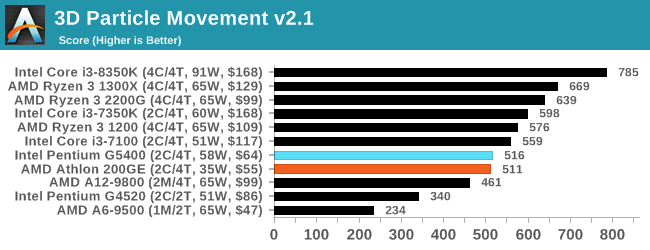
For pure unoptimized throughput, both processors are similar in the 3DPM test.
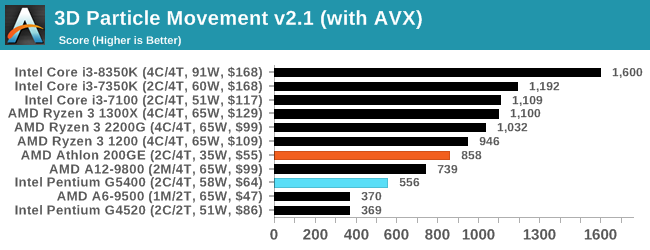
But if we crank on the tuned AVX code, the AMD 200GE scores a big win. On the Pentium, the different code path had almost zero effect, with less than a 10% increase in performance, but the 200GE went up by a good 60% by comparison.
Dolphin 5.0: Console Emulation
One of the popular requested tests in our suite is to do with console emulation. Being able to pick up a game from an older system and run it as expected depends on the overhead of the emulator: it takes a significantly more powerful x86 system to be able to accurately emulate an older non-x86 console, especially if code for that console was made to abuse certain physical bugs in the hardware.
For our test, we use the popular Dolphin emulation software, and run a compute project through it to determine how close to a standard console system our processors can emulate. In this test, a Nintendo Wii would take around 1050 seconds.
The latest version of Dolphin can be downloaded from https://dolphin-emu.org/
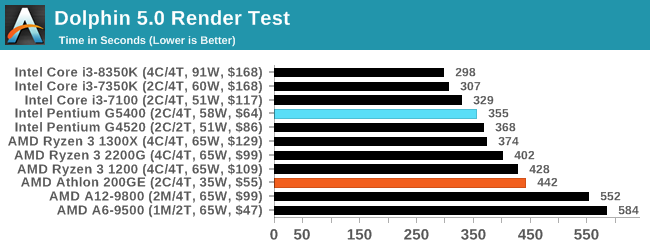
Our emulation test has always been a strong performer for Intel CPUs.
DigiCortex 1.20: Sea Slug Brain Simulation
This benchmark was originally designed for simulation and visualization of neuron and synapse activity, as is commonly found in the brain. The software comes with a variety of benchmark modes, and we take the small benchmark which runs a 32k neuron / 1.8B synapse simulation, equivalent to a Sea Slug.
We report the results as the ability to simulate the data as a fraction of real-time, so anything above a ‘one’ is suitable for real-time work. Out of the two modes, a ‘non-firing’ mode which is DRAM heavy and a ‘firing’ mode which has CPU work, we choose the latter. Despite this, the benchmark is still affected by DRAM speed a fair amount.
DigiCortex can be downloaded from http://www.digicortex.net/
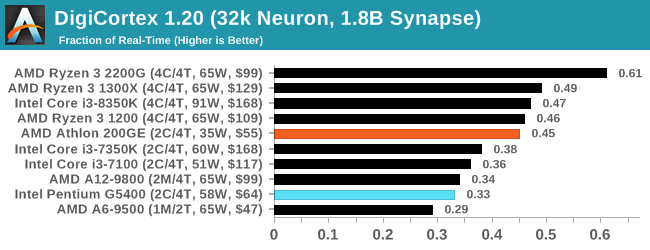
On this more memory limited test, the official supported frequency of the 200GE comes into play, and it scores 37% more than the Intel chip.
y-Cruncher v0.7.6: Microarchitecture Optimized Compute
I’ve known about y-Cruncher for a while, as a tool to help compute various mathematical constants, but it wasn’t until I began talking with its developer, Alex Yee, a researcher from NWU and now software optimization developer, that I realized that he has optimized the software like crazy to get the best performance. Naturally, any simulation that can take 20+ days can benefit from a 1% performance increase! Alex started y-cruncher as a high-school project, but it is now at a state where Alex is keeping it up to date to take advantage of the latest instruction sets before they are even made available in hardware.
For our test we run y-cruncher v0.7.6 through all the different optimized variants of the binary, single threaded and multi-threaded, including the AVX-512 optimized binaries. The test is to calculate 250m digits of Pi, and we use the single threaded and multi-threaded versions of this test.
Users can download y-cruncher from Alex’s website: http://www.numberworld.org/y-cruncher/
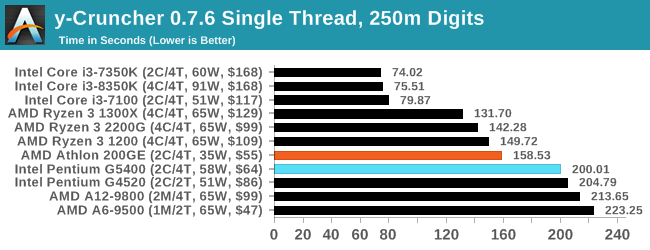
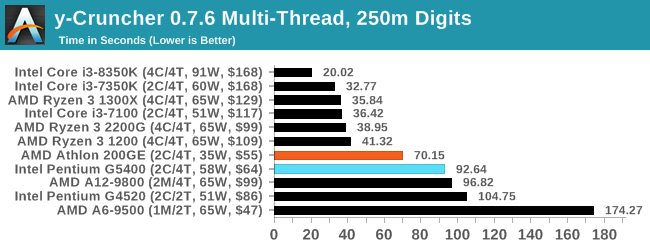
For our second AVX optimized test, AMD again scores a win. It would appear that the Pentium chips from Intel do not seem to be implementing the performance uplifts we see with the Core models.
Agisoft Photoscan 1.3.3: 2D Image to 3D Model Conversion
One of the ISVs that we have worked with for a number of years is Agisoft, who develop software called PhotoScan that transforms a number of 2D images into a 3D model. This is an important tool in model development and archiving, and relies on a number of single threaded and multi-threaded algorithms to go from one side of the computation to the other.
In our test, we take v1.3.3 of the software with a good sized data set of 84 x 18 megapixel photos and push it through a reasonably fast variant of the algorithms, but is still more stringent than our 2017 test. We report the total time to complete the process.
Agisoft’s Photoscan website can be found here: http://www.agisoft.com/
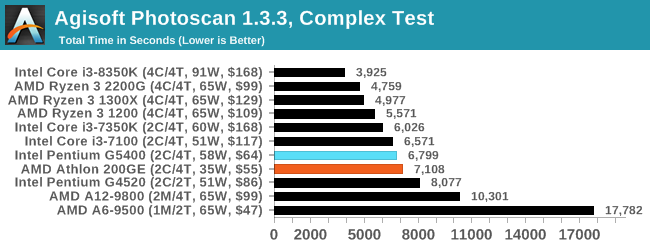
Photoscan is more of a mixed workload, with multithreaded and singlethreaded steps to get a good sense of a performance. The Intel processor slips a win here, a few percent faster than the AMD.


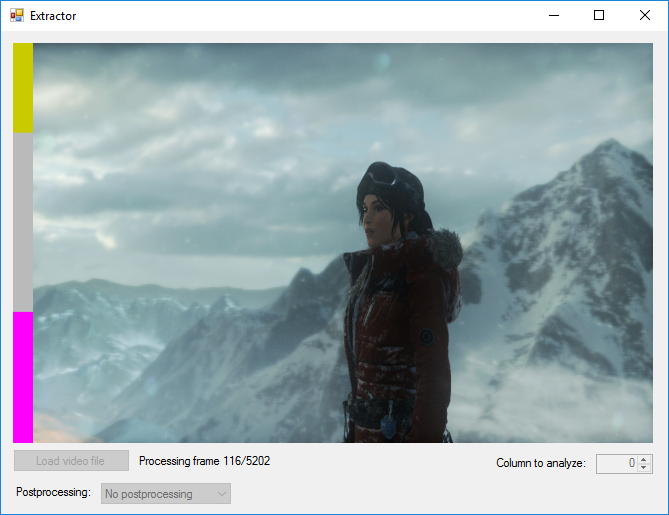










95 Comments
View All Comments
Irata - Tuesday, January 15, 2019 - link
The price push happened after the release - but do check Anandtech graphics cards reviews - they do have a tendency of mentioning current street / retail prices for both AMD and nVidia cards, which is how it should be.This is from the RX580 review:
"The biggest challenge right now is that GTX 1060 prices have come down to the same $229 spot just in time for the RX 500 series launch, so AMD doesn’t have a consistent price advantage"
yannigr2 - Tuesday, January 15, 2019 - link
Assimilator is a known Intel Nvidia hardcore fan. Ignore him.The_Assimilator - Wednesday, January 16, 2019 - link
Yes, pointing out facts makes me a fanboy. You a Trump voter by any chance?sonny73n - Tuesday, January 15, 2019 - link
@The_AssimiatorAre we not supposed to complain about the misleading pricing - one is Manufacturer’s SUGGESTED Retail Price and the ACTUAL price from the link provided by this article?
If I want to build a cheap office system NOW, should I take this article into consideration despite the huge price differences?
What’s special about the G5400 that its price has tripled due to “shortage”? At $182.68 currently from the link, is there no better CPU from Intel I can get for that price? Is Intel the only CPU manufacturer?
What are you trying to achieve by calling us name? What our criticism to AT has to do with you?
I’ve been restraining myself from criticizing AT too much. AT articles are slow to produce already. I wouldn’t want AT writers quit/fired then we’ll have less to read, even they’re written poorly.
kkilobyte - Tuesday, January 15, 2019 - link
What would have made the most sense is not writing such an article in the first place, then.I take Ian's own words on this: "I'm a big advocate of building a system piece by piece with the best you can afford at the time".
And at the (current) time, it seems that one simply cannot afford the G5400 for $64 (except maybe out of pure luck). This should have been, taken into account into the conclusion, or at least underlined.
AnnoyedGrunt - Tuesday, January 15, 2019 - link
Neither of these CPUs makes much sense. The G5400 isn't readily available (sold out on Newegg or only available from re-sellers for $100, as is the G5500 or G5600).Once you are spending $100, it makes much more sense to get the Ryzen 2200G for the same price that typically outperforms both of these (or only loses by a little to the G5400 in office type of tasks). The 2200G actually looks pretty decent as an IGP solution, and is a much better platform once you go to a dedicated GPU as well.
I'd personally work a few extra hours and save up for the 2200G over either of these options.
-AG
Valantar - Tuesday, January 15, 2019 - link
Despite all the complaints here of comparing products at very different price points (retail, not MSRP), I would still like to see a more complete test suite run on the overclocked 200GE, especially the gaming tests.Also, is iGPU overclocking possible on this chip, or are iGPU frequencies locked? It would also be very interesting for you to part out example builds of this vs. the G5400 and the Ryzen 3 2200G, to see the difference in actual system cost.
br83taylor - Tuesday, January 15, 2019 - link
Are those power figures correct? If you compare Ryzen 3 2200g for 20W and Ryzen 3 1300X at 58W. A third of the power but same 4C4T configuration.Zoolook13 - Tuesday, January 15, 2019 - link
For what it's worth, in Sweden the prices match pretty well 695 SEK for a 220GE vs 759 SEK for a G5400.Zoolook13 - Tuesday, January 15, 2019 - link
Sorry that ended up in the wrong place, edit button ftw...